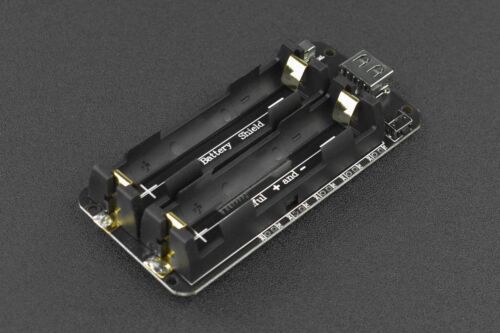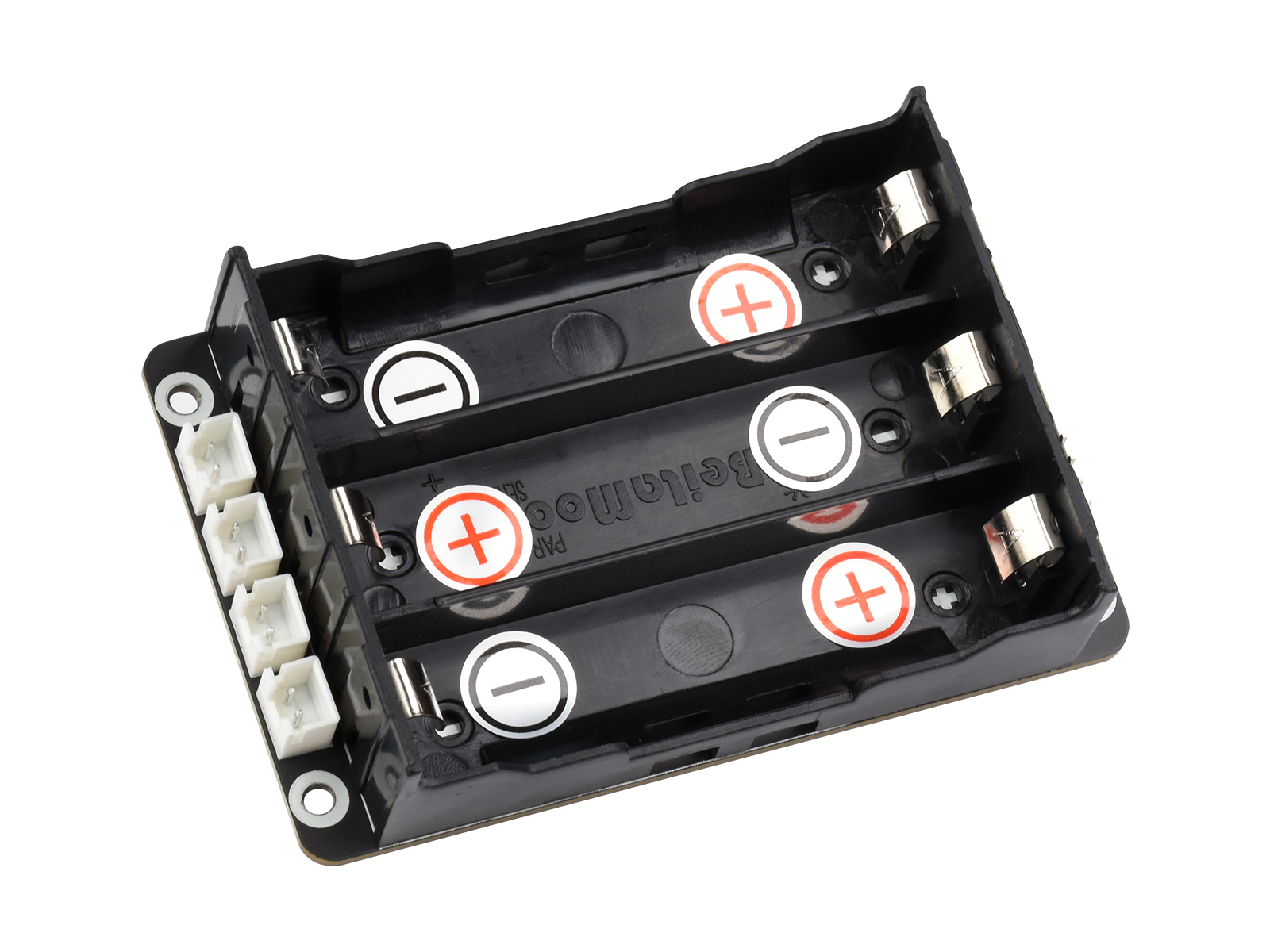This is a placeholder topic for “2-Way 18650 Battery Holder” comments.

This easy-to-use 16850 battery holder with dual-slot offers micro and type-C charging inputs, five 5V/2A output ports, five 3.3V/1A output ports and one…
Read moreThis is a placeholder topic for “2-Way 18650 Battery Holder” comments.

This easy-to-use 16850 battery holder with dual-slot offers micro and type-C charging inputs, five 5V/2A output ports, five 3.3V/1A output ports and one…
Read moreI’m considering using one of these to power a portable speaker. Would the battery holder need to be turned on each time the speaker is used even though the amp has its own power switch? Many thanks for your assistance and patience with a total beginner. ![]()
Depends on the portable speaker.
If it has a 5V power connection and an audio input connection then Yes.
These devices will have an audio power AMP built in which needs power to work.
If it is just a speaker with only audio in then you don’t need the battery holder at all.
Can you post a pic of the portable speaker connections and the AMP; that way we can give more accurate advice.
The output of an audio power AMP will damage the audio input of a portable speaker; if the speaker has its own power AMP.
Regards
Jim
Thanks so much for your prompt response, Jim. I’m actually looking at using the DF Robot High Power Amplifier listed on this site. I’ve chosen this amp board specifically because of the integrated power/volume knob as it will work for a key design feature of the housing I plan to build. However, I’d rather avoid having to have two power switches. I can’t seem to find an 18650 battery holder on your site that has an in-built charger without also having its own dedicated power switch. Grateful for your advice.
@Abby262255 that makes more sense now.
So the battery holder is to power the AMP and audio comes via the bluetooth.
The AMP has an integrated on off switch / volume control and the battery holder has a push button switch. The battery holder has a auto shutdown feature where it will switch off if the current drain fall too low. (120mA or 40mA) So when the AMP is not in use the battery holder will power itself off.
I think what you want is a power supply that is basically on all the time, battery powered and includes a built in USB-C charger.
You probably have figured this already, I am just stating for my own thoughts.
The battery holder in this post is not the right device for what you want to do.
The auto shutdown feature is to conserve battery power and protect whatever it is connected to the battery holder. Power banks use a similar feature to stop trickle charge of a mobile phone, as is not good for the phone battery when it is at full capacity to constantly receive current.
As the AMP will work from 5V to 27V it might be better to look at what is available in a higher voltage range.
The board will output adequate power only when the audio input and power source voltage/current are sufficient. The higher the power supply voltage, the larger the output power. Besides that, speaker impedance also changes the amplifier board power output. Please note that in the case of enough voltage and current, the larger the speaker impedance in ohms, the smaller the output power.
12V–8Ω speaker/24W(left channel)+24W(right channel), 4Ω speaker/40W+40W
15V–8Ω/32W+32W,4Ω/>60W+60W
19V–8Ω/64W+64W,4Ω/>80W+80W
24V–8Ω/72W+72W,4Ω/>100W+100W
At 5V the likely AMP power would be less than 10Watts.
Does it have to be battery powered ??
At high power the battery pack would be depleted pretty quick.
If you can use mains power, a laptop power supply at 24V / 2 to 3A would provide full AMP power.
Hope you can find a solution, depends on what you want the AMP to do.
Regards
Jim
As the amp does not have a power supply, what does the existing on-off switch actually do? If it simply comes out to some wires designed to connect to the external power, then the task is simply choosing the right battery.
Note that your application does not require a regulated supply. Including the regulator wastes battery power and makes it more difficult to get to the connection to the battery to completely isolate it when the amp is turned off.
If I was doing this I would use a pair of 18650 in series for 7.4V and a separate BMS module, with the connection to the battery wired through the amp on/off switch. But that might be a more extensive construction than you want to do.
For example:
2 Cell 18650 Series Batteries Holder
2S 3A 18650 Protection Charger Board
Hi there! I looked at the specs but wanted to confirm - how do I connect this to my Rpi Model 4B+ in order to supply power to the Rpi? Can I do it via the USB-C connector, or do I need to solder things?
USB-A to USB-C cable. The USB-C port on the Pi 4B+ does not use USB-C PD, so normal cable is ok.
(the Pi 5 needs a USB-C PD supply)
Regards
Jim
Hi I was wondering about the 2 way 18650 battery holder. What is the required input mA to charge. How long will it charge when batteries are depleted. Can you have current drawing in the input 5volts and current drawing out at the outputs say two 5 volt ports and the USB port at the same time. So can it charge and power at the same time.
Thanks
Allan
According to the manufacturer, “…this product does not support charging and discharging at the same time. It may not be used as a UPS.”
Hi Allan,
Welcome to the forum!!
Unfortunately there isnt a listed input current, though to comply with USB spec (which products like this unfortunately dont always do) ought to be 500/900mA @ 5V.
Time spent charging will depend on the capacity of the batteries and charge rate, this number would be best found experimentally rather than by calculating.
And Jeff has got you for the final question!
What kind of projects were you looking to power with this board? We might be able to track down a better alternative ![]()
Liam
can it charge and power at the same time.
This product supports charging and discharging at the same time. But is twice the price.
UPS is the key word.

Uninterruptible Power Supply (UPS) Module, Supports charging And Power output at the same time, 3S & 5V 5A Output...
Price: AUD 40.9
Regards
Jim
Thanks, how much is the control interface with leads for the UPS battery module you recommended the one that’s twice the price. What’s the input voltage for it.
Thanks again
Allan Roberts
Hi Jim again, I was wondering is there a 5volt input UPS battery charger module that you have in stock? Does it have a control interface. Will it need it to run.
Thanks
Allan Roberts
I am a Core Electronics customer, I linked one of their products that supports charging and discharging at the same time. An item I remember seeing some time ago.
The Wiki says it needs 12.6V 2A input to charge the batteries. (4.2V LiPo’s x 3 = 12.6V)
It is not clear in the WiKi, but I think it needs a separate LiPo charger, as linked by Core on their web page. In my opinion it is not a very useful device if it needs another device to work correctly as an UPS.
The Jetson Nano UPS might be a better item. It has 5V input according to the web page and seems to be pretty flexible; but is it $86.50. (search for UPS on Core web site)
As to whether it is in stock, I have no idea, you should contact Core direct.
This is help forum where like minded techo’s try to help each other.
Regards
Jim
Hi James
This has come up before not long ago.
The charging voltage for a nominal 3.7V LiPo is 4.2V. 3X4.2=12.6.
What is required as input is a 12.6V @ 2A power supply. It does not require the fancy multi cell charger. It has all the battery management such as constant current, constant voltage and cell balancing built in. If you did use the multi cell charger you would only use the 12.6V output, all the other charger functions would be redundant.
In use you would connect the 12.6V to the input, connect your load to the appropriate outputs and use it as an UPS. Mains power fails then the battery takes over the supply to the load until the battery depletes. In normal use the mains should restore before the battery gets to the cut off stage (all going well) and charging should commence. The load current should be confined to a value that allows the supply 2A (24W) to operate the load AND charge the battery.
Cheers Bob
Thanks for your input @Robert93820.
I didn’t want to say a 12.6V power supply would be all you need because the Wiki was not 100% clear. Sometimes Waveshare are not clear in what they mean. I haven’t examined the circuit in much detail to figure out how it works.
I linked it mainly as an example of an UPS and what Allan should be looking for. In any case he is after a 5V input UPS, so I mentioned the Jetson Nano, at first look it seems to be pretty good but not cheap.
Anyway, thanks for your help.
Cheers
Jim
Hi James
Sometimes Waveshare are not clear in what they mean
Change that to read “nearly always”. But at least you can find a schematic. BUT there are a couple of things marked “Option” and nowhere can I find if this “Option” is fitted to this device or not. But I suppose it is better than the nothing some manufacturers offer.
I find that I just won’t purchase if enough information is not available to judge whether an item will do the job I require or not. There is always someone else that will.
Cheers Bob
Hi Allan,
Dialing back your questions, what kind of project will you be using this for? These holders unfortunately behave more like a battery bank than a UPS.
If you can give us some more insight to your project we may be able to offer a list of parts you can use to make the solution you want.
Liam
Hi - given it does not support charging and discharging at the same time, why when I plug into the USB-C port to charge, does the USB-A output turn on (without me having pressed the ON button). That means I have to physically remove the USB-A to charge via the USB-C without it powering my device at the same time (and therefore charging/discharging simulatenously). Any ideas appreciated. Thank you.